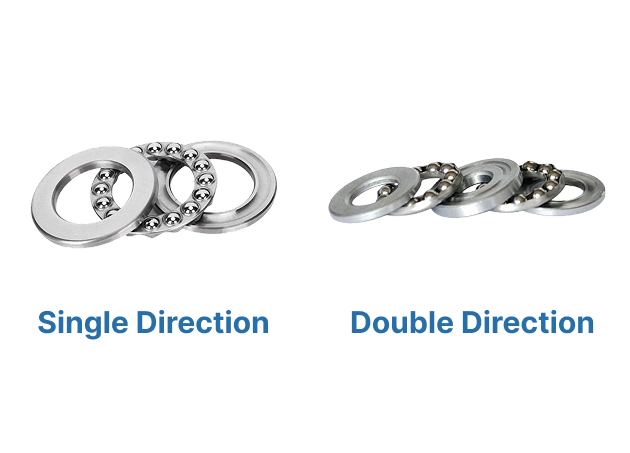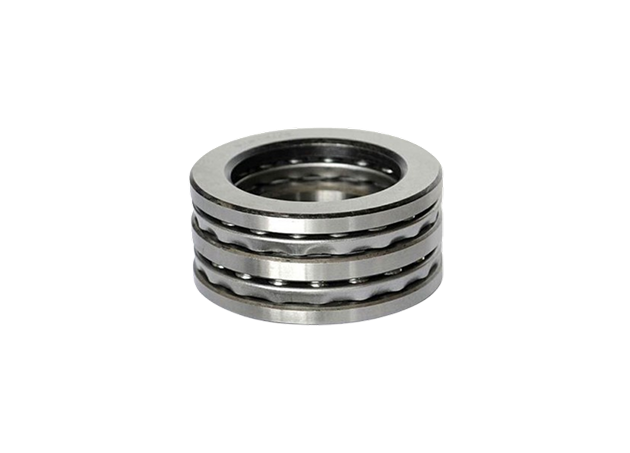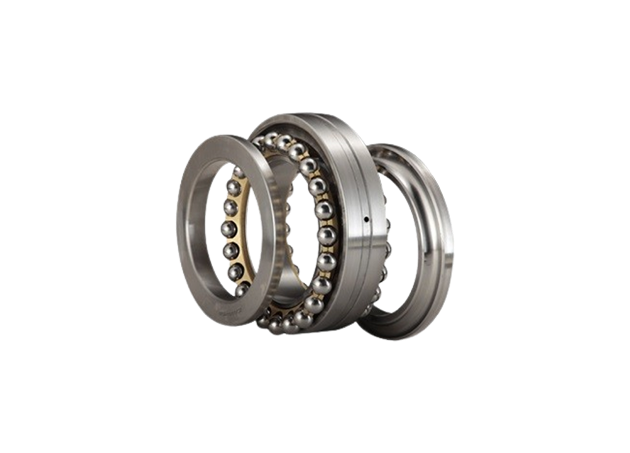Home / Product / Ball Bearings / Thrust Ball Bearings / Double Direction Thrust Ball Bearings
Double Direction Thrust Ball Bearings

Double direction thrust ball bearings are engineered to handle axial loads in both directions simultaneously.
These bearings are ideal for applications requiring high load capacity and stability, such as automotive transmissions and heavy machinery.
Their robust design ensures optimal performance, making them a reliable choice for demanding industrial environments.
Loading...
Total 57 Results
Part Number
Bore Dia
Outer Dia
Width
Chamfer Dimension Housing Washer
Chamfer Dimension Shaft Washer
Inner Dia Housing Washer
Cage Material
Dynamic Thrust Load
Static Thrust Load
Max Speed
Weight
52202
10 mm
32 mm
22 mm
0.6 mm
0.3 mm
17 mm
Stainless Steel
3578 lbf
5625 lbf
7500 rpm
0.081 kg
52204
15 mm
40 mm
26 mm
0.6 mm
0.3 mm
22 mm
Stainless Steel
4770 lbf
8438 lbf
6000 rpm
0.15 kg
52205
20 mm
47 mm
28 mm
0.6 mm
0.3 mm
27 mm
Stainless Steel
5962 lbf
11250 lbf
5300 rpm
0.22 kg
52305
20 mm
52 mm
34 mm
1 mm
0.3 mm
27 mm
Stainless Steel
7762 lbf
13500 lbf
4500 rpm
0.33 kg
52406
20 mm
70 mm
52 mm
1 mm
0.6 mm
32 mm
Stainless Steel
15795 lbf
27450 lbf
3200 rpm
1 kg
52206
25 mm
52 mm
29 mm
0.6 mm
0.3 mm
30 mm
Stainless Steel
5648 lbf
11475 lbf
5000 rpm
0.25 kg
52306
25 mm
60 mm
38 mm
1 mm
0.3 mm
32 mm
Stainless Steel
8055 lbf
14738 lbf
4000 rpm
0.47 kg
52407
25 mm
80 mm
59 mm
1.1 mm
0.6 mm
42 mm
Stainless Steel
17122 lbf
30825 lbf
2800 rpm
1.45 kg
54306
25 mm
60 mm
41.3 mm
1 mm
0.3 mm
32 mm
Stainless Steel
8055 lbf
14738 lbf
3800 rpm
0.58 kg
52207
30 mm
62 mm
34 mm
1 mm
0.3 mm
37 mm
Stainless Steel
7898 lbf
16538 lbf
4300 rpm
0.41 kg
52208
30 mm
68 mm
36 mm
1 mm
0.6 mm
42 mm
Stainless Steel
9945 lbf
21712 lbf
3800 rpm
0.55 kg
52307
30 mm
68 mm
44 mm
1 mm
0.3 mm
35 mm
Stainless Steel
11115 lbf
21712 lbf
3400 rpm
0.68 kg
52308
30 mm
78 mm
49 mm
1 mm
0.6 mm
40 mm
Stainless Steel
13905 lbf
27450 lbf
3000 rpm
1.05 kg
52408
30 mm
90 mm
65 mm
1.1 mm
0.6 mm
42 mm
Stainless Steel
21510 lbf
41175 lbf
2400 rpm
2.05 kg
54207
30 mm
62 mm
37.8 mm
1 mm
0.3 mm
37 mm
Stainless Steel
7898 lbf
16538 lbf
4000 rpm
0.53 kg
54307
30 mm
68 mm
47.2 mm
1 mm
0.3 mm
37 mm
Stainless Steel
11115 lbf
21712 lbf
3400 rpm
0.85 kg
54308
30 mm
78 mm
54.1 mm
1 mm
0.6 mm
42 mm
Stainless Steel
13905 lbf
27450 lbf
3000 rpm
1.17 kg
52209
35 mm
73 mm
37 mm
1 mm
0.6 mm
47 mm
Stainless Steel
8775 lbf
19462 lbf
3600 rpm
0.6 kg
52309
35 mm
85 mm
52 mm
1 mm
0.6 mm
47 mm
Stainless Steel
17122 lbf
34425 lbf
2800 rpm
1.25 kg
52409
35 mm
100 mm
72 mm
1.1 mm
0.6 mm
47 mm
Stainless Steel
27900 lbf
54000 lbf
2200 rpm
2.7 kg
54209
35 mm
73 mm
39.6 mm
1 mm
0.6 mm
47 mm
Stainless Steel
8775 lbf
19462 lbf
3600 rpm
0.78 kg
54309
35 mm
85 mm
56.2 mm
1 mm
0.6 mm
47 mm
Stainless Steel
17122 lbf
34425 lbf
2800 rpm
1.6 kg
54409
35 mm
100 mm
78.9 mm
1.1 mm
0.6 mm
47 mm
Stainless Steel
27900 lbf
54000 lbf
2000 rpm
3 kg
52210
40 mm
78 mm
39 mm
1 mm
0.6 mm
52 mm
Stainless Steel
11115 lbf
26100 lbf
3400 rpm
0.71 kg
52310
40 mm
95 mm
58 mm
1.1 mm
0.6 mm
52 mm
Stainless Steel
18428 lbf
38250 lbf
2600 rpm
1.75 kg
54310
40 mm
95 mm
64.7 mm
1.1 mm
0.6 mm
52 mm
Stainless Steel
18428 lbf
38250 lbf
2400 rpm
2.3 kg
54410
40 mm
110 mm
83.2 mm
1.5 mm
0.6 mm
52 mm
Stainless Steel
33300 lbf
68625 lbf
1900 rpm
4.45 kg
52211
45 mm
90 mm
45 mm
1 mm
0.6 mm
57 mm
Stainless Steel
13162 lbf
30150 lbf
3000 rpm
1.1 kg
52311
45 mm
105 mm
64 mm
1.1 mm
0.6 mm
57 mm
Stainless Steel
22725 lbf
50400 lbf
2200 rpm
2.4 kg
52411
45 mm
120 mm
87 mm
1.5 mm
0.6 mm
57 mm
Stainless Steel
43875 lbf
90000 lbf
1800 rpm
4.7 kg
54211
45 mm
90 mm
49.6 mm
1 mm
0.6 mm
57 mm
Stainless Steel
13162 lbf
30150 lbf
3000 rpm
1.3 kg
52212
50 mm
95 mm
46 mm
1 mm
0.6 mm
62 mm
Stainless Steel
13320 lbf
31500 lbf
2800 rpm
1.2 kg
52312
50 mm
110 mm
64 mm
1.1 mm
0.6 mm
62 mm
Stainless Steel
22725 lbf
50400 lbf
2200 rpm
2.55 kg
52412 M
50 mm
130 mm
93 mm
1.5 mm
0.6 mm
62 mm
Brass
44775 lbf
96750 lbf
1700 rpm
6.35 kg
54312
50 mm
110 mm
70.7 mm
1.1 mm
0.6 mm
62 mm
Stainless Steel
22725 lbf
50400 lbf
2200 rpm
2.9 kg
52213
55 mm
100 mm
47 mm
1 mm
0.6 mm
67 mm
Stainless Steel
13612 lbf
33750 lbf
2800 rpm
1.35 kg
52313
55 mm
115 mm
64 mm
1.1 mm
0.6 mm
67 mm
Stainless Steel
23850 lbf
54000 lbf
2200 rpm
2.75 kg
52314
55 mm
125 mm
72 mm
1.1 mm
1 mm
72 mm
Stainless Steel
30375 lbf
72000 lbf
2000 rpm
3.65 kg
52414 M
55 mm
250 mm
107 mm
2 mm
1 mm
123 mm
Brass
52650 lbf
123750 lbf
1100 rpm
9.7 kg
52215
60 mm
110 mm
47 mm
1 mm
1 mm
77 mm
Stainless Steel
14332 lbf
38250 lbf
2600 rpm
1.55 kg
52315
60 mm
135 mm
79 mm
1.5 mm
1 mm
77 mm
Stainless Steel
36675 lbf
87750 lbf
1800 rpm
4.8 kg
52216
65 mm
115 mm
48 mm
1 mm
0.6 mm
82 mm
Stainless Steel
17122 lbf
46800 lbf
3400 rpm
1.7 kg
52316
65 mm
140 mm
79 mm
1.5 mm
1 mm
82 mm
Stainless Steel
35775 lbf
87750 lbf
1800 rpm
4.94 kg
54416 M
65 mm
170 mm
128.5 mm
2.1 mm
1 mm
83 mm
Brass
69075 lbf
168750 lbf
1200 rpm
17.5 kg
52217
70 mm
125 mm
55 mm
1 mm
1 mm
88 mm
Stainless Steel
21938 lbf
61875 lbf
2200 rpm
2.4 kg
54317
70 mm
150 mm
95.2 mm
1.5 mm
1 mm
88 mm
Stainless Steel
39150 lbf
91125 lbf
1500 rpm
7.95 kg
52218
75 mm
135 mm
62 mm
1.1 mm
1 mm
93 mm
Stainless Steel
25200 lbf
65250 lbf
2000 rpm
3.2 kg
54420 M
80 mm
210 mm
159.9 mm
3 mm
1.1 mm
103 mm
Brass
83475 lbf
238500 lbf
1000 rpm
29 kg
52220
85 mm
150 mm
67 mm
1.1 mm
1 mm
103 mm
Stainless Steel
26775 lbf
73125 lbf
1800 rpm
4.2 kg
52320
85 mm
170 mm
97 mm
1.5 mm
1 mm
103 mm
Stainless Steel
50625 lbf
128250 lbf
1400 rpm
8.95 kg

Unique Bidirectional Load-Carrying Capacity
The structure of a double direction thrust ball bearing is unique, consisting of two opposing rows of balls. These rows share the same cage and bearing housing washer (also known as the seat washer).
This sandwich-like design is the key difference between double direction and single direction thrust ball bearings. Unlike the single direction type, the shaft washers and housing washers of a double direction thrust ball bearing each have their own raceways, allowing the bearing to support pure axial loads from both directions.
Therefore, if your main requirement is to handle axial forces coming from both directions, this type is your ideal choice.
The Ideal Choice for Pure Axial Loads
Unlike angular contact bearings, which are designed to handle combined loads, double direction thrust ball bearings are almost exclusively engineered to support axial loads.
Free from the influence of radial forces, they manage axial loads with high efficiency, ensuring smooth and precise machine performance. This makes them a popular choice in applications such as machine tool spindles, screw drive systems, and high-precision rotary mechanisms.
If your equipment demands accurate positioning without the need for high-speed operation, double direction thrust ball bearings are an excellent solution.


Minimum Load Requirements
To ensure proper operation, double direction thrust ball bearings—like ball and roller bearings—must be bear a minimum load, especially under high speeds, rapid acceleration, or rapid changes in load direction.
In such conditions, the inertia of the balls and cage, along with internal lubricant friction, can negatively affect bearing performance. This may result in harmful sliding between the balls and raceways.
When starting at low temperatures or using high-viscosity lubricants, a higher minimum load may be required. In most cases, the weight supported by the bearing and any external forces—particularly in vertical shaft applications—already exceed the minimum load requirement. If not, a preload should be applied, such as using a spring mechanism.
FREQUENTLY ASKED QUESTIONS

Can I use double direction thrust ball bearings if my equipment needs to support very light radial loads?
No, double direction thrust ball bearings are designed exclusively for axial loads(thrust load). If subjected to radial loads, the bearing may be damaged. Even very light radial forces can negatively impact the bearing’s service life. Therefore, if both radial and axial loads are present, it's recommended to use a suitable type of angular contact bearing.
Are double direction thrust ball bearings suitable for high-speed operation?
No, they are not suitable for high-speed operation.
Due to the influence of centrifugal force, the rotational speed of thrust ball bearings is generally lower than that of radial bearings. Excessive speed can lead to slippage or increased wear. You can find detailed information about max speeds on the product detail pages of our catalog.
How can I find the bearing model I need on your website?
You can click the search button at the top right corner of the website to directly search for the specific model you need.
Alternatively, you can browse through the product categories step by step to find the desired ball bearing or roller bearing.
If you need further assistance, feel free to contact us directly.